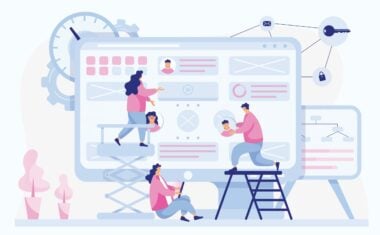Free UX Design Course
Dive into UX design with our free starter course. Transform your creative ideas into user-friendly solutions.
For most, a career in tech involves life-long learning—knowing how to stay up to date on the latest trends can be just as important as your foundational education. Nowhere is this truer than in the case of UX designers, the tech professionals who build digital experiences that are both intuitive and enjoyable for users.
Anyone can learn how to become a UX designer with the right skills, knowledge, and dedication. But to have a long-lasting career in UX design, you’ll also need to stay up-to-date on the latest technology and design trends, in addition to possessing an understanding of web development, user needs, brand identity, and the business objectives at hand.
If you’re wondering how you can learn all of this, and stay current, then you’re in the right place. Below, we’ll tell you all about the steps required to become a UX designer, and how to continue on your learning journey after you’ve landed your first job.
Is It Easy To Learn UX (User Experience) Design?
Yes, it is relatively easy to learn UX design. Although it requires a lot of practice and dedication, many resources are available to help beginners get started. Aspiring UX designers find it helpful to take online courses, attend conferences, and work with mentors to learn the fundamentals of UX design. On top of that, there are many books, blogs, and websites about UX design, as well as UX communities, that can offer support and guidance.
How To Learn UX Design: Different Learning Paths

Are you keen on pursuing a UX design career but unsure how to get started? Don’t worry, we’ve got you covered! Here are some of the most common learning paths you can follow to become a successful UX designer.
-
Formal Education
-
UX Design Bootcamp
-
Self-Taught Route
Formal Education
UX design is a complex field that requires a deep understanding of user research, interface design, and usability, which you can develop through formal education.
University Degree
University degrees provide a strong foundation of knowledge and skills, including but not limited to the following:
- User research and testing
- Design principles
- Interface design
- Usability
You’ll learn about the history of UX design and its roots in psychology, psychology, and sociology—all of which are crucial to understanding how people interact with technology. You’ll also learn about human-computer interaction, which is essential for designing intuitive and easy-to-use interfaces.
Plus, you’ll get a foundation in coding and software development that will help you build your portfolio as you grow your career.
Community College
There are a lot of benefits to attending a community college when it comes to becoming a UX designer.
For one thing, it’s much cheaper than other schools that offer similar programs. Additionally, many faculty members and instructors at community colleges have practical experience in the field, which means they can help you learn more about the industry.
Community colleges also tend to have smaller classes than other schools, which gives you more opportunities for one-on-one time with your professors or classmates.
Certificate Program
A UX design certificate program is a great way to jumpstart your career in the field and gain the skills you need to become a successful UX designer.
Certificate programs provide a structured learning environment that helps you stay focused and motivated and allow you to ask questions and get expert feedback.
A certificate program also provides the opportunity to network with experienced industry professionals and build meaningful connections. You will learn from experienced designers and mentors, allowing you to gain firsthand insight into the challenges of UX design.
UX Design Bootcamp
A bootcamp typically involves intensive learning over a short period, teaching participants about UX design principles and techniques.
By attending a UX design bootcamp, you can build a portfolio of work and gain the confidence and skills to start a UX design career. These bootcamps provide a great way to learn and practice in a supportive, collaborative environment, allowing participants to make mistakes and learn from them.
Self-Taught Route
The self-taught route can work if you are comfortable learning independently and motivated to do the necessary research and practice. Here are some of your options.
Massive Open Online Courses (MOOC)
Massive Open Online Courses (MOOCs) are typically offered by universities and colleges. MOOCs provide learners with an opportunity to gain knowledge and skills in a variety of subject areas without having to attend classes physically.
The benefits of MOOCs include flexible learning, a large selection of courses and topics, and access to instructors and other students.
General Online Courses
Online courses can provide a comprehensive introduction to the field and allow students to explore different UX design topics at their own pace. They are also invaluable resources for staying up-to-date with industry trends and techniques.
One of the best online UX design courses available is Springboard’s UX Design Course. This comprehensive course covers topics ranging from user experience research and product design to usability and accessibility. Students will also have access to industry-leading mentors, UX resources, and career coaching to help them launch their UX careers.
YouTube Channels
If you want to learn UX design, YouTube is a great place to start. Videos on the platform come in all different lengths—from ultra-brief 5-minute clips to hours-long lectures.
The advantages of learning UX design from YouTube include:
- Flexibility: You can learn UX design at your own pace and on your own time. This makes it a great option for those who have busy schedules or those who are busy working on other projects.
- Variety: There are a variety of videos available on YouTube related to UX design, so you can find content that is tailored to your learning needs.
- Cost: Learning from YouTube is free, making it an attractive option for those who are on a budget.
- Community: YouTube is a great place to connect with other UX designers and get feedback on your work.
Websites and Blogs
Blogs and websites are helpful resources for learning about the latest trends in the industry. Many UX designers read blogs to stay up-to-date on what’s happening in their field and use them to find new tools or approaches to try out when working on projects.
Books
Learning UX design from books is most effective when combined with hands-on practice. Hands-on learning is essential for truly understanding how to design a user-friendly experience.
Some of the most renowned UX design books include The Elements of User Experience by Jesse James Garrett, Designing for Emotion by Aarron Walter, and Lean UX: Designing Great Products with Agile Teams by Jeff Gothelf and Josh Seide.
Learning UX Design: A Step-By-Step Guide

Let’s explore the fundamentals of learning UX design and how to get started in the field.
Ensure UX Design Is Right For You
Before taking a leap into UX design, take the time to understand the skills, knowledge, and qualifications needed to succeed as a UX designer. Talk to people in the field or look for online resources to understand the profession better.
Assess your current skillset and identify possible areas for improvement. Consider the design process and the projects you would like to work on.
Don’t be scared to try out some UX design projects or experiments. This will give you a better idea of working in the field and help you determine if it’s a good fit for you.
Learn the Foundations
If you’re looking for a good way to get started with UX, we recommend starting with a little dose of the basics. These include user-centered design, usability, accessibility, responsive design, information architecture, and user testing.
Then, deepen your knowledge by doing the following:
- Take classes. Look for UX classes in your local area or online. Many universities provide UX courses or even degrees in UX design.
- Attend conferences and events. Attending meetings and events related to UX is a great way to stay up to date with the latest trends and learn from experienced professionals.
- Participate in online communities. There are a lot of online communities and forums related to UX where you can ask questions and get answers from experienced professionals.
Invest Time in Learning, Training, and Education
Investing your time in learning is essential before changing careers. Learn the tools of the trade, such as prototyping software and design tools. These will help you create great user experiences.
Understanding the business context of UX design is also essential, as it will help you understand the impact of design decisions on the bottom line.
Identify Your Niche
Identifying your niche in UX design can be overwhelming, as there are many sub-niches to choose from. But it’s one of the quickest ways to excel in your career.
To identify your niche, start by exploring different areas of UX design. Examples of UX design sub-niches include user interface design, user research, user experience analytics, information architecture, usability testing, and product design. Think about which areas you are passionate about and which you are skilled in. Consider the specific industry or product type you want to focus on.
Once you’ve identified a niche that you’re interested in, the next step is to research and learn more about that area. Get familiar with the terminology and tools used for that field. Join online communities, attend workshops, and connect with professionals to gain insights and advice. Look for mentors who can provide guidance and advice.
Develop Key Skillsets

UX design skills involve a combination of research, design, and technology. Here are some of the most valuable skills you should possess as a UX designer:
Technical Skills
A UX designer must have a strong foundation in technology and design principles. This includes understanding the fundamentals of design methodologies such as user-centered design, graphic design, user interface design, and information architecture.
You should also understand the different platforms and technologies used to create user experiences, such as HTML, CSS, JavaScript, and responsive web design. Possessing software skills, such as using prototyping tools like Adobe XD, InVision, and Figma is also beneficial.
Soft Skills
Soft skills enable UX designers to effectively collaborate with clients and colleagues while also being able to communicate effectively and be flexible when needed.
One of the most critical soft skills that a UX designer needs is strong communication and problem-solving skills. This involves being able to articulate complex ideas clearly and effectively to clients, as well as being able to break down complex problems and find creative solutions. Empathy is also appreciated, as it relates to your ability to understand the needs and goals of the user and to design solutions that reflect those needs and goals.
Learn the Essential Tools and Software

UX designers use various tools and software to create compelling user experiences. These include wireframing and prototyping tools such as Sketch, Figma, and Adobe XD, user research tools such as UserTesting, Hotjar, and SurveyMonkey, and analytics tools such as Google Analytics and Mixpanel.
The best way to become familiar with these tools and software is to use them. Many of these offer free trials, so it’s easy to test out different ones and find the one that best suits your needs. Additionally, there are many online tutorials and courses available that can help you become familiar with them.
Gain Practical Experience
Gaining practical experience when becoming a UX designer allows you to gain valuable hands-on experience with the UX design process and an understanding of the user-centered design principles that drive UX design.
Here are some ways you can get hands-on experience:
Contribute To Open-Source or Sample Projects
Start small with a manageable and achievable project. This will help you gain confidence and improve your skills. Moreover, being part of an open-source project allows you to collaborate with other UX designers and ask for feedback.
Make sure to research the product or project before you begin. Understand the goals and objectives of the project, the target audience, the technology being used, and the design environment. This will ensure your design is successful and effective.
Participate in UX Design Competitions
Research your competition thoroughly before you sign up for a contest. Make sure you understand the criteria and the format of the competition. Look at the work of previous winners to gain valuable insights into what makes a great UX design.
When it comes to your project, create a simple, focused, clear, and well-structured design. Understand the audience, use cases, and the context of the project.
Pursue an Internship
An internship is a great way to learn about the field and determine whether or not it’s something you want to pursue.
It allows you to put your ideas into practice and gain valuable experience with UX design tools and processes like user research, wireframing, prototyping, etc. while giving you time to work on projects that matter to you.
Internships also allow you to network with other professionals and learn from their experiences.
Freelance Work
Whether or not you should take up freelance work to become a UX designer is up for debate. Some think freelancing is the best way to get experience and build their portfolio. Others believe that it’s better to get a job at a company and learn as much as possible in an environment where you have support.
What is the best way to make sure freelancing works for you? Be prepared! Plan exactly how many hours per day or week you will work on your projects, and be ready to fail and learn from your mistakes.
Shadow a UX Designer
Shadowing a UX designer can give you an insight into the day-to-day activities and challenges of the role, as well as the strategies used to create successful projects. It can help you understand the complexities of the profession and provide you with a better understanding of the UX design process.
Get To Know Other Design Students
Kashif Ross
UX Analyst at Circulo
Micole Simpson
UX Designer at Skipify
April Hoang
UX Designer at Microsoft
Join the UX Design Community
As a UX designer, getting involved in the community is beneficial in many ways. It can help you stay up to date on the latest trends in user experience, as well as help you find new opportunities and ideas to apply to your work. Here are some ways to do that:
Slack Communities
Slack is a communication platform that allows you to connect with other designers and share ideas, resources, inspiration, and even work.
There are many different Slack communities out there—some focus on specific types of design (like Illustration or UX), while others are more general and open to any kind of design practice. Each Slack community has its unique vibe and culture, so it’s important to do your research before jumping into one.
Some examples include the lean_UX community and UX Collective.
Conferences
Many conferences offer workshops and seminars tailored to UX designers, and attending these events can help you stay ahead of the curve. Attending conferences can help you build relationships with potential employers and collaborators, opening up more career opportunities.
LinkedIn is a great place to build your network as a UX designer. It’s a professional platform, so it’s best to consider it an extension of your resume. If you don’t have any work experience yet, that’s okay—you can still use LinkedIn to build relationships with people in the industry and learn more about what they do.
You can also use LinkedIn to find companies that offer UX design jobs and reach out to them directly, which can be helpful if you’re looking for something specific or want to get your name out there.
Mentorship
Mentorship is an excellent way to learn UX design. It allows you to get one-on-one time with someone who can help you navigate the industry. They can also advise you on how to approach your career confidently.
Learning UX Design and Starting a Career: Real-Life Examples and Stories
Here are two real-life examples from experienced professionals who have been in your shoes before.
Lily Cameron
Lily Cameron tells the story of how she became a UX designer in three months, despite having no experience. She talks about her struggles to find the right path and emphasizes the importance of working on your projects to build a portfolio and reaching out to the right people at the companies she wanted to work for. Finally, she talks about the power of networking and how it was key to her success in landing the job she wanted.
Laís Lara Vacco

To achieve a successful career in UX design, Laís recommends setting clear goals and tracking your progress. Long-term goals should be focused on learning UX and UI design and applying your knowledge to real projects. She suggests various soft and hard skills books and talks about the importance of applying the knowledge you acquire from online courses to real-life projects.
How To Learn UX Design FAQs
We’ve got the answers to your most frequently asked questions:
Can I Learn UX on My Own?
You can absolutely learn UX design by yourself. There are tons of resources out there that can help you get started, and if you’re willing to put in the time and effort, you’ll be able to learn all about UX design in no time.
Is a UX Design Bootcamp Worth It?
A UX design bootcamp is a great way to launch your career as a UX designer. However, make sure to assess the quality of the bootcamp and determine if it will help you reach your goals.
Does UX Design Require Coding?
Not necessarily. While coding can benefit UX designers, it is not a requirement. UX designers typically focus on the user experience. However, some UX designers might use coding skills to create prototypes or implement new features.
How Long Does It Take To Learn UX Design?
Generally speaking, becoming proficient in UX design can take 3 to 12 months of dedicated study and practice.
Since you’re here…
Are you a future UX designer? Enroll in our UI/UX Bootcamp and join over 10,000 students who have successfully changed careers with us. Want to get wireframing right this second? Check out our free UX design course today.








